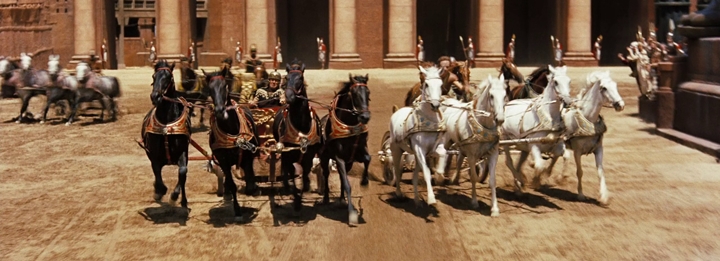In 1953, 20th Century Fox changed the way we saw movies at the theater by introducing widescreen at an aspect ratio (width divided by height) of 2.35:1. It was called CinemaScope. Up until that point, movies were shot at the Academy ratio of 1.375:1. Several other widescreen aspect ratios were ultimately created by the various movie studios, including the most common one used nowadays, 1.85:1.
The way these movies at several different aspect ratios were projected was at a constant height. That way, all movies would be seen with different widths. Some early widescreen movies were at 2.66:1, and one, Ben Hur (1959), was at 2.76:1. An example from the Chariot Race is shown below (© Copyright MGM Studios). These days, the widest aspect ratio is generally 2.35:1.

A comparison of what you would see, depending on the aspect ratio, is shown at the top of this page.
When studios informed movie theaters a couple of years ago that they had to convert their projectors to handle only digital versions of movies, everything changed. I have noticed that we now see movies projected at a constant width, just like we have on our HDTVs at home. Movies at 1.85:1 are shown full screen, while 2.35:1 movies are shown with black bars at the top and bottom.
![]()
So, the term “Widescreen” is no longer relevant, because high aspect ratio movies are not seen any wider than the 1.85:1 movies.
The biggest problem with this is that the 2.35:1 movies are using only 0.7872% of the pixels that 1.85:1 movies are using. So, on a 1080p HDTV, instead of using 2,073,600 pixels (1920 x 1080), they use 1,632,408 pixels. At a theater, where movies are shown in 4K, instead of using 8,847,360 pixels (4096 x 2160), they use 6,964,642 pixels.
However, there are additional problems at the theater.
I have noticed that movies are now shown with digital projectors at such high brightness, the black levels are very poor, with the darkest parts of a scene being gray rather than black. The black bars at the top and bottom of the screen are not black. They are gray. This is a deterioration from what we saw when film was projected.
Secondly, the sound volume is turned up far too loud. I literally have to watch the movie using dark glasses in order to improve the black levels and keep from being blinded by the brightness. I also put torn pieces of napkins in my ears to reduce the loudness to a reasonable level.
So, it would appear that “Widescreen” is no longer a relevant term, at least at the Cineplex where I go to see movies.
I suggest that movie theaters use a zoom lens on the front of the projector to increase the width of 2.35:1 movies on the screen compared to movies shown at 1.85:1. I would assume that the original projection screens with additional width are still there, so this should not be a problem. I would also suggest that movies which are going to be projected at 2.35:1 aspect ratio be shot with a 1.27 squeeze using an anamorphic camera lens, then unsqueezed at the theater by a reverse anamorphic lens. This way, all of the 4K pixels would be used.
And, please turn down the brightness and volume level.

